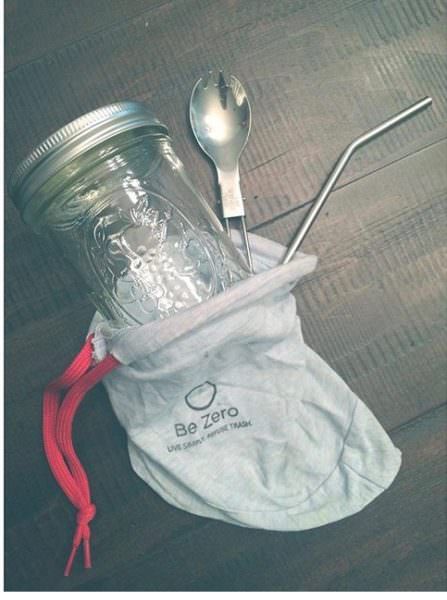What the heck does it mean to live a zero waste lifestyle? Can I really not make any trash?
Don’t let the term fool you. Zero waste is an industrial term referring to a circular economy in which all processes of design (the plan for how it’ll be made), manufacturing (how it’s made), consumption (how you’ll consume it), disposal (what you’ll do with it after you’re done), and recovery (can that thing be used again or not?) are designed to reduce or eliminate waste.
Needless to say, we are far from that. In our current linear economy, products are designed to flow from manufacturing to purchase to our trashcans — and subsequently, the landfill.

Saying you live a zero waste lifestyle doesn’t mean you generate zero trash. It means you are becoming more informed about how products are designed, where they come from, and ultimately what happens to them when we are done using them. And you’re using that information to reduce your waste.
So what kind of power do we hold as consumers? A lot!

What the heck does it mean to live a zero waste lifestyle? Image credit: Be Zero
Note: This post contains affiliate links. If you make a purchase through one of these links, we receive a small commission that helps fund our Recycling Directory, the most comprehensive in North America.
Putting Value on Zero Waste
Living a zero waste lifestyle is about massively reducing the amount of trash we produce each day. It’s about putting value back into our belongings, resources, and ecosystems. It’s about simplifying and getting back into touch with our local communities. And it’s about stepping back from our over-consumerism and understanding our trash footprint.
It’s going to take many voices and collective action to shift the way we create, consume, and dispose of things. We need a collective effort to move our society from a linear economy of designing products for the trashcan to a circular economy.
So when you say you are living a zero waste lifestyle, you are saying you want to drastically eliminate the amount of trash you create, send a message to businesses and manufacturers to design and take responsibility for their products, and be an example of circular — that is, a zero waste — economy. It’s not about being perfect or creating zero trash; it’s about urging our society towards a more intentional design and consumer culture and creating a lifestyle that rejects our throwaway culture.

Zero waste isn’t about being perfect or creating zero trash; it’s about being a positive activist. Image credit: Be Zero
Rethink Trash
How can we rethink our trash, develop more sustainable habits, and make a lot less trash?
1. Simplify
There are lots of ways we can simplify our lives, and it’s going to look different for every single person. Simplifying our lifestyles can simply come to evaluating our true needs and wants.
- What really brings me joy?
- What do I really use?
- What are the things that inspire me and bring beauty into my life?
When we simplify, we edit down our possessions and create more space! With fewer distractions, we feel less overwhelmed. Stuff takes up space and it also takes up our mental energy.
Asking questions like these can help us to curb our consumerism and put value and meaning back into the items we own and use. We are more likely to invest in something that has more lasting qualities and is repairable and multifunctional.
2. Refuse Single-Use Disposables/Become Materially Mindful
We weren’t always wasteful. In fact, many cultures embraced resourcefulness, quality design, craftsmanship, and product integrity. Today, many products are designed without these qualities. Planned obsolescence is a business strategy of designing a product with an intentionally limited useful life, so it will become obsolete, unfashionable, or useless within a given timeframe. “That is a thing!?” Yes, and many of today’s products are designed with this in mind.
3. Reuse and Repeat

Carrying your own set of reusable utensils instead of using plastic disposables is an easy way to reduce waste. Image credit: Be Zero
One of the simplest ways to drastically reduce your trash is to find durable, lasting, reusable alternatives to single-use disposable items.
Here are a few simple swaps:
- Reusable coffee cup instead of disposable plastic-lined coffee cups.
- Say no to plastic straws when ordering drinks. If you can’t go without, invest in some reusable straws.
- Bring your own produce bags instead of plastic produce bags (or just put the veggies right into your cart).
- Bring your own shopping bags.
- Carry a handkerchief.
- Carry your own set of reusable utensils instead of using plastic disposable utensils.
- Take a small glass or metal container with you for leftovers.
- Shop around the edges of the grocery store. (Hint: That’s where the vegetables, fruits, and less processed foods usually are.)
- Reduce your waste by avoiding prepackaged foods. They are more expensive upfront. Plus, with the internet, it’s easy to learn how to make your own healthy and cost-effective simple meals. Cooking doesn’t have to be time consuming or expensive.
Even in the home, you can:
- Switch to a safety razor instead of disposable or replaceable razor head cartridges.
- Use cloth rags instead of paper towels.
- Switch to 100% recycled toilet paper that comes wrapped individually in recycled paper instead of plastic wrap.
- Use reusable food wraps instead of cling wrap.
- Switch to plant-based bristle brushes and kitchen sponges instead of plastic-based bristles.
- Make your own simple cleaning solutions.
Community and Consumer Power
Companies and businesses need to hear from you! Consumer demand triumphs all. Give them an incentive (ahem, your loyalty = your money!) to make changes to their packaging and policies.
Get in touch with your community about sharing programs, local community gardens, farmer’s markets, car-sharing programs, compost pick-up businesses. And encourage businesses to rethink their trash footprint by opting out of plastic-based or styrofoam to-go containers, straws, and to offer compost and recycling options. And when in doubt, follow Be Zero’s Guide: How to Make Less Trash — The Simple Way:

Image courtesy of Be Zero
Feature image credit: crazystocker / Shutterstock. Originally published on June 29, 2016, this article was updated in September 2020.
The post How To Make Less Trash the Simple Way appeared first on Earth 911.








